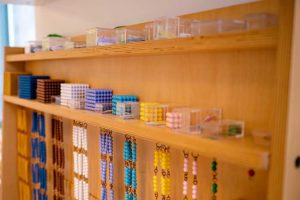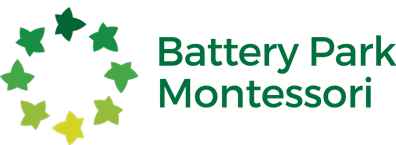Curriculum Overview at Battery Park Montessori
An Overview of Our Curriculum
 In an authentic Montessori program, the child, environment and teacher create a learning triangle. Dr. Maria Montessori and researchers since have found that when children work in such environments – ones where the parameters are clear and where teachers respect children’s developmental differences and interests – there is a sense of trust, which allows deep concentration and learning to take place.
In an authentic Montessori program, the child, environment and teacher create a learning triangle. Dr. Maria Montessori and researchers since have found that when children work in such environments – ones where the parameters are clear and where teachers respect children’s developmental differences and interests – there is a sense of trust, which allows deep concentration and learning to take place.
At Battery Park Montessori, we pay close attention to how we foster these skills in our children. We often discuss the nature of the materials and how we could present them so to maximize a child’s stamina and concentration for we recognize that skills such as attention and sustained focus are paramount to a child’s learning.
The teaching and learning of languages is also towards that end. Learning more than one language, particularly during a child’s sensitive period to sounds, has a profound effect on the plasticity of a child’s brain. The back and forth between sounds promotes the categorization of those sounds within the brain and enhances mental flexibility. Like a muscle, the more one “toggles” back and forth between languages, the stronger the muscle gets. These repeated opportunities for practice allows for both language and executive function skills to become sharper. To learn more about how we maintain the integrity of the Montessori program with our languages, please see our Trilingual Montessori Language Program.
Classroom Design

In Montessori, the classroom is a key part of the curriculum. Each subject area (math, language arts, science, etc) have designated areas where related materials are stored on low open shelves, available for students to choose. These materials (we call each one “a work”) are sequenced by complexity so that learners can make decisions about the level of challenge they would like to engage. All works are self-correcting. This means that a student can use them independently of teacher support, although teachers are always present and observing in case support is needed.
Although each Montessori environment is special and unique, they do resemble one another with respect to how the environment is arranged. Every Montessori preschool classroom is divided into the five main Montessori subject areas: Practical Life, Sensorial Development, Language, Mathematics, and Culture & Sciences, and my classroom is no different. Additionally, there is usually an area set aside for artistic projects and outdoor area for play and further experiential learning.
We also consider the more “transactional” areas of the school as part of our curriculum. Student cubbies, where shoes are changed and coats and belongings are stored, represent an important area of growth as students learn to manage themselves independently at the start and end of each day. The bathroom is equally important, as this is where important life skills are learned, and again, students are supported in gradually becoming fully independent in toileting.
We call the main classroom “the prepared environment”. This is because the magic of Montessori lies in our teachers’ extensive planning and preparation of the classroom. The space is prepared each and every day in response to student choices and behaviors closely observed by our teachers.
For example, if a teacher observes that a learner is advancing quickly through math works, that teacher will take new works from our hidden storage and place them on the shelves to be available to that student the next day. And then the teacher will be sure to present any new works the next day so that all students become aware of them and know how to engage them.
Here is a breakdown of our classroom or “prepared environment”:
The Montessori Prepared Environment: Subject Areas
Cultural Area
The cultural area is divided into geography, history, nature and science. There are many geography materials in the classroom to teach a child their place in the world. History assists a child in learning about the concept of change. By looking at the seasons, studying the weather and changing the calendar daily it helps the child to establish a cycle of time. When a child’s birthday arrives there is a special lesson that occurs: a representation of the sun is placed on the floor and the birthday child holds the globe and walks around. Montessori nomenclature activities for vocabulary building, and a variety of other manipulatives to spark an interest in botany, zoology and geography and to help our Montessori preschool students explore and discover the world around them.
Math Area
We have two shelves that house our Montessori Math materials and a separate shelf that holds the Golden Bead Material. The first shelf houses materials and activities to reinforce quantities and numerals 1 to 10 (Large and Small Number Rods, Sandpaper Numbers, Spindle Box, Cards and Counters, Counting Puzzles, Bead Stair 1 to 9, Bead Stair Frame, etc). The other shelving unit holds materials for adding and subtracting as well as the Seguin Boards for teaching and reinforcing teens and counting by tens.
Language Arts Area
Our Montessori classroom has two shelves for the Language Arts materials and a variety of materials to teach and reinforce sounds, writing and reading. There are name tracing cards with tracing paper, “Eye Spy” Tray, Sandpaper Letters, Cornmeal Tray, Language Stepboard, Moveable Alphabet, Wooden Reading Cards, Sight Word Bingo, and a variety of materials for reinforcing phonetic reading.
Practical Life Area
A beautiful dressing frame stands along with three shelves allocated for Practical Life – they are by far the most popular shelves in the whole Montessori preschool classroom. The Practical Life activities help students become responsible members of society. The activities help them learn and express a sense of order, independence, respect for the environment, respect for others, and at the same time, help to refine their concentration and hand-eye coordination. The Montessori Practical Life shelves are full of activities to reinforce pouring, spooning, tonging, dusting, sweeping, napkin folding, mixing colors, making bubbles, folding laundry, hanging clothes, using a screwdriver, locks and keys, screws and bolts, setting a table, using a whisk, etc. We change the activities regularly so there are always new and exciting activities to refine the children’s fine motor skills and promote increased concentration skills.
Sensorial Area
The Montessori Sensorial shelf is another popular area of the classroom with so much to explore and discover. Each scientifically designed material isolates a quality found in the world, such as color, size, shape, etc. which focuses the attention on that one aspect. Also available are the Pink Tower, Cylinder Blocks, Color Tablets, Knobless Cylinders, Smelling Bottles, Binomial Cube, Trinomial Cube and much more to explore through the senses!
Reading Area and Book Shelf
As part of the Montessori Language Arts curriculum, we maintain a vast library of award-winning children’s literature in all three languages: English, Mandarin and Spanish. Books are everywhere and every subject section has subject-related books to help learners build contextual understanding. Even our “treehouses” have book baskets, and children love getting cozy with a book in the treehouse.
Science Shelf and Nature Table
This part of the Culture & Science curriculum is where the children can feel like scientists and have plenty of opportunities to try new experiments, explore an assortment of nature items, use a magnifying glass and microscope, work with magnets, and experiment with the sink and float activity. Throughout the year we encourage our Montessori students to bring in new and exciting things for our nature table and we enjoy everything from tadpoles to fungus!
Outdoor Area
The children’s outdoor play area is an important part of our curriculum. A beautiful expansive patio that fronts the Hudson River and is surrounded by trees, this space serves both recreational activities and our learning garden, which students maintain year round. This Montessori outdoor environment fosters respect and appreciation for nature and there are plenty of opportunities for raking, watering, planting, running, jumping, bubble blowing and discovering.
Art
There are easels in every space and art-related works on the shelves. We provide a variety of open-ended art activities that include; stamping, cutting, modeling dough, collage activities, coloring, tracing, painting, crayon rubbings, etc.
Peace Table
A Peace Table is used by the children for conflict resolution through peaceful and respectful communication. When used for conflict resolution, it encourages children to talk about what’s on their mind and gives them a specific place and method to achieve an agreeable solution.
The Role of the Teacher at Battery Park Montessori
In addition to preparing the space, one will notice that our teachers’ roles are different from those found in traditional classrooms. Instead of being the disseminator of information, our Montessori teachers act as facilitators, exemplars and observers.
Facilitator: You will notice that our teachers provide guidance and support as children work at their own pace. Teachers balance their presentations by providing support when needed and then walking away to allow children opportunities for exploration.
Exemplar: You will notice that our teachers are role models in all ways, particularly in exemplifying grace and courtesy through their actions and statements. Whether it is walking through the classroom quietly or deliberately unfolding a napkin before lunch, our teachers are cognizant of the fact that our children are watching.
Observer: You will notice that our teachers observe children as to extrapolate the child’s needs and next learning steps. At Battery Park Montessori, they input those observations into our shared observation platform and consistently meet in small teams to discuss.

